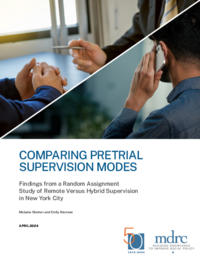Comparing Pretrial Supervision Modes
Findings from a Random Assignment Study of Remote Versus Hybrid Supervision in New York City

The U.S. jail population has tripled over the last 30 years due to surges in the use of pretrial detention and money bail. On any given day, nearly 450,000 people in the United States are detained while awaiting the resolution of their criminal charges. Many of these individuals, still legally innocent, are in jail because they cannot afford to pay the bail amount set as a condition of their release. Pretrial detention takes a significant toll on the lives of affected individuals, putting them at increased risk of continued involvement with the criminal legal system as well as of losing their jobs, housing, and child custody.
As a result, jurisdictions across the United States are reforming their pretrial systems to reduce the number of people who are held in pretrial detention—that is, who remain in jail while they await the adjudication of their cases. As part of this effort, many jurisdictions are moving away from money bail as a primary means of encouraging people to return for future court dates. Instead, they are increasingly relying on alternatives such as pretrial supervision, which requires released people to meet regularly with supervision staff members while their cases are pending. Pretrial supervision has traditionally required clients to report for in-person meetings, particularly for those assessed as being at relatively high risk of failing to attend a court hearing or of being rearrested.
With the onset of the COVID-19 pandemic, however, many pretrial supervision programs shifted in-person meeting requirements to remote check-ins to protect the health of both clients and staff members. For many jurisdictions, this shift highlighted some of the benefits of remote supervision, which include time savings for clients balancing work, school, caregiving, or other responsibilities, and less resource-intensive administration for supervision providers, potentially generating cost savings. At the same time, some members of the pretrial community questioned whether remote supervision was as effective as in-person interaction at meeting clients’ needs and protecting public safety. As the pandemic waned, it remained unclear whether remote supervision was as effective as in-person or hybrid (a mix of in-person and remote) supervision in achieving the main goals of supervision programs: helping clients make their court appearances and avoid new arrests during the pretrial period.
This report presents new evidence on the effects of remote supervision compared with hybrid supervision, based on the results of a randomized controlled trial conducted in the Queens borough of New York City. The trial found that:
- Remote supervision can be used in place of hybrid supervision while achieving the same levels of court appearance and avoidance of new felony charges.
- Remote supervision may allow a range of supervision clients to meet the conditions of their release with less disruption to their daily lives and improved ability to handle job, childcare, and other responsibilities during the pretrial period. Given the study’s eligibility criteria, however, it is not known whether these benefits extend to the highest-need and -risk clients, many of whom were not included in the study sample.
- Staff members and clients acknowledged that both modes of supervision have strengths and challenges, though the clients interviewed for this study felt more positively about remote supervision. There was general agreement that the appropriate supervision mode may vary based on the client’s needs and preferences.






